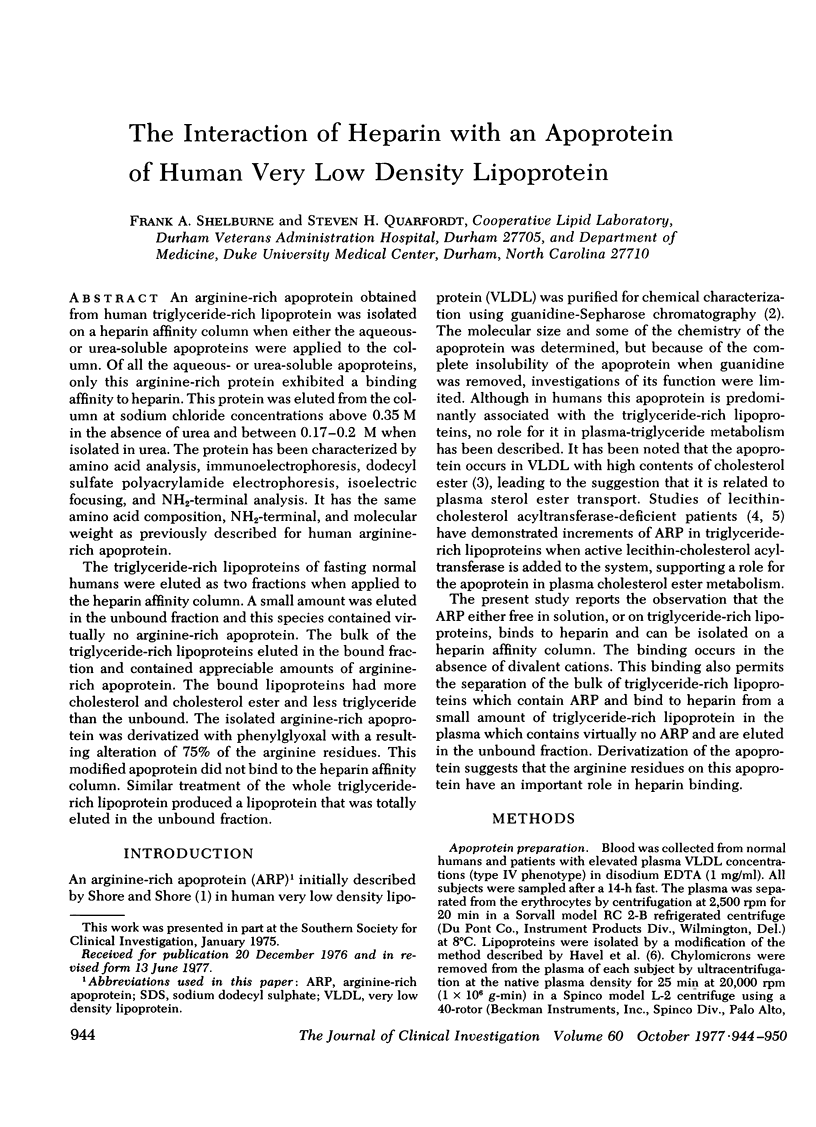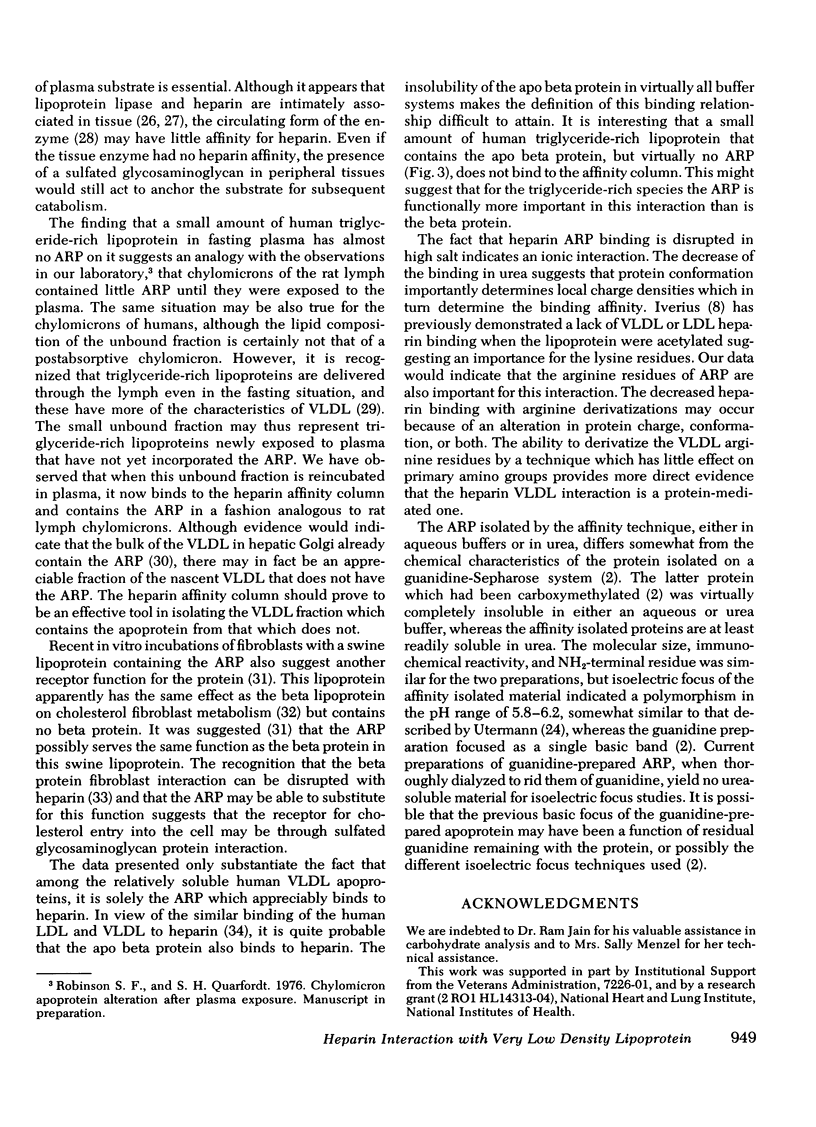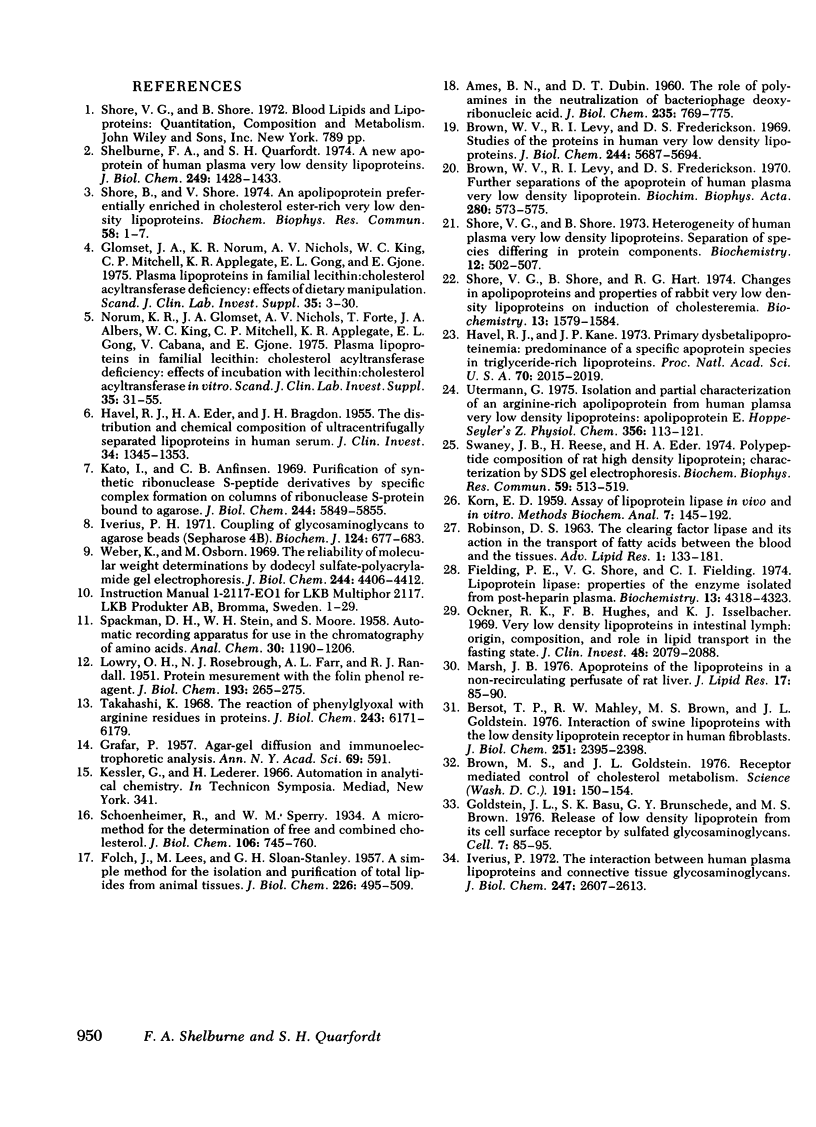Abstract
An arginine-rich apoprotein obtained from human triglyceride-rich lipoprotein was isolated on a heparin affinity column when either the aqueousor urea-soluble apoproteins were applied to the column. Of all the aqueous- or urea-soluble apoproteins, only this arginine-rich protein exhibited a binding affinity to heparin. This protein was eluted from the column at sodium chloride concentrations above 0.35 M in the absence of urea and between 0.17-0.2 M when isolated in urea. The protein has been characterized by amino acid analysis, immunoelectrophoresis, dodecyl sulfate polyacrylamide electrophoresis, isoelectric focusing, and NH2-terminal analysis. It has the same amino acid composition, NH2-terminal, and molecular weight as previously described for human arginine-rich apoprotein.
The triglyceride-rich lipoproteins of fasting normal humans were eluted as two fractions when applied to the heparin affinity column. A small amount was eluted in the unbound fraction and this species contained virtually no arginine-rich apoprotein. The bulk of the triglyceride-rich lipoproteins eluted in the bound fraction and contained appreciable amounts of arginine-rich apoprotein. The bound lipoproteins had more cholesterol and cholesterol ester and less triglyceride than the unbound. The isolated arginine-rich apoprotein was derivatized with phenylglyoxal with a resulting alteration of 75% of the arginine residues. This modified apoprotein did not bind to the heparin affinity column. Similar treatment of the whole triglyceride-rich lipoprotein produced a lipoprotein that was totally eluted in the unbound fraction.
Full text
PDF






Images in this article
Selected References
These references are in PubMed. This may not be the complete list of references from this article.
- AMES B. N., DUBIN D. T. The role of polyamines in the neutralization of bacteriophage deoxyribonucleic acid. J Biol Chem. 1960 Mar;235:769–775. [PubMed] [Google Scholar]
- Bersot T. P., Mahley R. W., Brown M. S., Goldstein J. L. Interaction of swine lipoproteins with the low density lipoprotein receptor in human fibroblasts. J Biol Chem. 1976 Apr 25;251(8):2395–2398. [PubMed] [Google Scholar]
- Brown M. S., Goldstein J. L. Receptor-mediated control of cholesterol metabolism. Science. 1976 Jan 16;191(4223):150–154. doi: 10.1126/science.174194. [DOI] [PubMed] [Google Scholar]
- Brown W. V., Levy R. I., Fredrickson D. S. Further separation of the apoproteins of the human plasma very low density lipoproteins. Biochim Biophys Acta. 1970 Mar 31;200(3):573–575. doi: 10.1016/0005-2795(70)90115-7. [DOI] [PubMed] [Google Scholar]
- Brown W. V., Levy R. I., Fredrickson D. S. Studies of the proteins in human plasma very low density lipoproteins. J Biol Chem. 1969 Oct 25;244(20):5687–5694. [PubMed] [Google Scholar]
- FOLCH J., LEES M., SLOANE STANLEY G. H. A simple method for the isolation and purification of total lipides from animal tissues. J Biol Chem. 1957 May;226(1):497–509. [PubMed] [Google Scholar]
- Fielding P. E., Shore V. G., Fielding C. J. Lipoprotein lipase: properties of the enzyme isolated from post-heparin plasma. Biochemistry. 1974 Oct 8;13(21):4318–4323. doi: 10.1021/bi00718a012. [DOI] [PubMed] [Google Scholar]
- GRABAR P. Agar-gel diffusion and immunoelectrophoretic analysis. Ann N Y Acad Sci. 1957 Dec 16;69(4):591–607. doi: 10.1111/j.1749-6632.1957.tb49699.x. [DOI] [PubMed] [Google Scholar]
- Glomset J. A., Norum K. R., Nichols A. V., King W. C., Mitchell C. D., Applegate K. R., Gong E. L., Gjone E. Plasma lipoproteins in familial lecithin: cholesterol acyltransferase deficiency: effects of dietary manipulation. Scand J Clin Lab Invest Suppl. 1975;142:3–30. [PubMed] [Google Scholar]
- Goldstein J. L., Basu S. K., Brunschede G. Y., Brown M. S. Release of low density lipoprotein from its cell surface receptor by sulfated glycosaminoglycans. Cell. 1976 Jan;7(1):85–95. doi: 10.1016/0092-8674(76)90258-0. [DOI] [PubMed] [Google Scholar]
- HAVEL R. J., EDER H. A., BRAGDON J. H. The distribution and chemical composition of ultracentrifugally separated lipoproteins in human serum. J Clin Invest. 1955 Sep;34(9):1345–1353. doi: 10.1172/JCI103182. [DOI] [PMC free article] [PubMed] [Google Scholar]
- Havel R. J., Kane J. P. Primary dysbetalipoproteinemia: predominance of a specific apoprotein species in triglyceride-rich lipoproteins. Proc Natl Acad Sci U S A. 1973 Jul;70(7):2015–2019. doi: 10.1073/pnas.70.7.2015. [DOI] [PMC free article] [PubMed] [Google Scholar]
- Iverius P. H. Coupling of glycosaminoglycans to agarose beads (sepharose 4B). Biochem J. 1971 Oct;124(4):677–683. doi: 10.1042/bj1240677. [DOI] [PMC free article] [PubMed] [Google Scholar]
- Iverius P. H. The interaction between human plasma lipoproteins and connective tissue glycosaminoglycans. J Biol Chem. 1972 Apr 25;247(8):2607–2613. [PubMed] [Google Scholar]
- Kato I., Anfinsen C. B. Purification of synthetic ribonuclease S-peptide derivatives by specific complex formation on columns of ribonuclease S-protein bound to agarose. J Biol Chem. 1969 Nov 10;244(21):5849–5855. [PubMed] [Google Scholar]
- LOWRY O. H., ROSEBROUGH N. J., FARR A. L., RANDALL R. J. Protein measurement with the Folin phenol reagent. J Biol Chem. 1951 Nov;193(1):265–275. [PubMed] [Google Scholar]
- Marsh J. B. Apoproteins of the lipoproteins in a nonrecirculating perfusate of rat liver. J Lipid Res. 1976 Jan;17(1):85–89. [PubMed] [Google Scholar]
- Norum K. R., Glomset J. A., Nichols A. V., Forte T., Albers J. J., King W. C., Mitchell C. D., Applegate K. R., Gong E. L., Cabana V. Plasma lipoproteins in familial lecithin: cholesterol acyltransferase deficiency: effects of incubation with lecithin: cholesterol acyltransferase in vitro. Scand J Clin Lab Invest Suppl. 1975;142:31–55. [PubMed] [Google Scholar]
- Ockner R. K., Hughes F. B., Isselbacher K. J. Very low density lipoproteins in intestinal lymph: origin, composition, and role in lipid transport in the fasting state. J Clin Invest. 1969 Nov;48(11):2079–2088. doi: 10.1172/JCI106174. [DOI] [PMC free article] [PubMed] [Google Scholar]
- ROBINSON D. S. THE CLEARING FACTOR LIPASE AND ITS ACTION IN THE TRANSPORT OF FATTY ACIDS BETWEEN THE BLOOD AND TISSUES. Adv Lipid Res. 1963;1:133–182. doi: 10.1016/b978-1-4831-9937-5.50010-7. [DOI] [PubMed] [Google Scholar]
- Shelburne F. A., Quarfordt S. H. A new apoprotein of human plasma very low density lipoproteins. J Biol Chem. 1974 Mar 10;249(5):1428–1433. [PubMed] [Google Scholar]
- Shore B., Shore V. An apolipoprotein preferentially enriched in cholesteryl ester-rich very low density lipoproteins. Biochem Biophys Res Commun. 1974 May 7;58(1):1–7. doi: 10.1016/0006-291x(74)90882-1. [DOI] [PubMed] [Google Scholar]
- Shore V. G., Shore B., Hart R. G. Changes in apolipoproteins and properties of rabbit very low density lipoproteins on induction of cholesteremia. Biochemistry. 1974 Apr 9;13(8):1579–1585. doi: 10.1021/bi00705a004. [DOI] [PubMed] [Google Scholar]
- Shore V. G., Shore B. Heterogeneity of human plasma very low density lipoproteins. Separation of species differing in protein components. Biochemistry. 1973 Jan 30;12(3):502–507. doi: 10.1021/bi00727a022. [DOI] [PubMed] [Google Scholar]
- Swaney J. B., Reese H., Eder H. A. Polypeptide composition of rat high density lipoprotein: characterization by SDS-gel electrophoresis. Biochem Biophys Res Commun. 1974 Jul 24;59(2):513–519. doi: 10.1016/s0006-291x(74)80010-0. [DOI] [PubMed] [Google Scholar]
- Takahashi K. The reaction of phenylglyoxal with arginine residues in proteins. J Biol Chem. 1968 Dec 10;243(23):6171–6179. [PubMed] [Google Scholar]
- Weber K., Osborn M. The reliability of molecular weight determinations by dodecyl sulfate-polyacrylamide gel electrophoresis. J Biol Chem. 1969 Aug 25;244(16):4406–4412. [PubMed] [Google Scholar]




